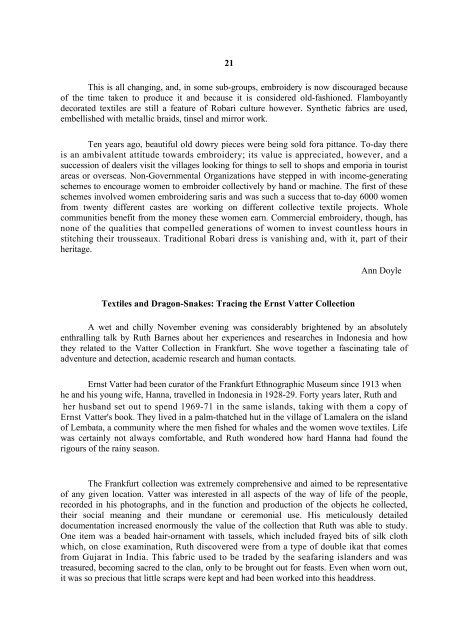download - OATG. Oxford Asian Textile Group
download - OATG. Oxford Asian Textile Group
download - OATG. Oxford Asian Textile Group
- No tags were found...
You also want an ePaper? Increase the reach of your titles
YUMPU automatically turns print PDFs into web optimized ePapers that Google loves.
21This is all changing, and, in some sub-groups, embroidery is now discouraged becauseof the time taken to produce it and because it is considered old-fashioned. Flamboyantlydecorated textiles are still a feature of Robari culture however. Synthetic fabrics are used,embellished with metallic braids, tinsel and mirror work.Ten years ago, beautiful old dowry pieces were being sold fora pittance. To-day thereis an ambivalent attitude towards embroidery; its value is appreciated, however, and asuccession of dealers visit the villages looking for things to sell to shops and emporia in touristareas or overseas. Non-Governmental Organizations have stepped in with income-generatingschemes to encourage women to embroider collectively by hand or machine. The first of theseschemes involved women embroidering saris and was such a success that to-day 6000 womenfrom twenty different castes are working on different collective textile projects. Wholecommunities benefit from the money these women earn. Commercial embroidery, though, hasnone of the qualities that compelled generations of women to invest countless hours institching their trousseaux. Traditional Robari dress is vanishing and, with it, part of theirheritage.Ann Doyle<strong>Textile</strong>s and Dragon-Snakes: Tracing the Ernst Vatter CollectionA wet and chilly November evening was considerably brightened by an absolutelyenthralling talk by Ruth Barnes about her experiences and researches in Indonesia and howthey related to the Vatter Collection in Frankfurt. She wove together a fascinating tale ofadventure and detection, academic research and human contacts.Ernst Vatter had been curator of the Frankfurt Ethnographic Museum since 1913 whenhe and his young wife, Hanna, travelled in Indonesia in 1928-29. Forty years later, Ruth andher husband set out to spend 1969-71 in the same islands, taking with them a copy ofErnst Vatter's book - They lived in a palm-thatched hut in the village of Lamalera on the islandof Lembata, a community where the men fished for whales and the women wove textiles. Lifewas certainly not always comfortable, and Ruth wondered how hard Hanna had found therigours of the rainy season.The Frankfurt collection was extremely comprehensive and aimed to be representativeof any given location. Vatter was interested in all aspects of the way of life of the people,recorded in his photographs, and in the function and production of the objects he collected,their social meaning and their mundane or ceremonial use. His meticulously detaileddocumentation increased enormously the value of the collection that Ruth was able to study.One item was a beaded hair-ornament with tassels, which included frayed bits of silk clothwhich, on close examination, Ruth discovered were from a type of double ikat that comesfrom Gujarat in India. This fabric used to be traded by the seafaring islanders and wastreasured, becoming sacred to the clan, only to be brought out for feasts. Even when worn out,it was so precious that little scraps were kept and had been worked into this headdress.
















